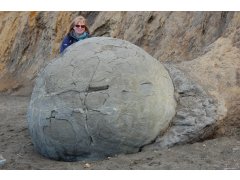The Moeraki Boulders lie in Otago, on the east coast of South Island, New Zealand. While similar features are found around the world, these boulders are remarkable for their size, up to 2m diameter, and their almost spherical shape. Well-known on the tourist trail, they are fairly easy to access and seen as being of national importance. The boulders littering the beach emerged from the eroding cliffs of soft mudstone in which they formed. The boulders are septarian concretions with cracks occupied by mineral deposits. In some examples the internal pattern is exposed.

Some 60 million years ago, sediment was accumulating on the sea floor, with small fragments such as shells and plants within it. Calcite slowly built up around organic nuclei, forming spherical nodules with harder outer layers while the inner material dehydrated to give cracks which spread radially out to the rim. The cracks themselves filled with varying mineral deposits as groundwater conditions changed. The largest boulders are thought to have taken more than four million years to form. Following uplift onto the landmass of New Zealand in a period of mountain building, erosion was able to expose the Palaeocene mudstone beds that contain the boulders and from which they continue slowly to emerge. The effects of weathering have removed some of the outer layers, allowing the inner structure to be seen and breaking up some boulders.
Although now protected by law, it is believed that many smaller boulders were removed from the beach prior to legislation. The newsletter item by Hayward (2014) considers the issue of geoconservation. The earthquake near Kaikoura in late 2016 has allowed similar boulders to be viewed following the uplift of the seafloor in that event. See this news item.
To find out more:
- The Moeraki Boulders, 1997. Miscellaneous series 9. Institute of Geological and Nuclear Sciences, Lower Hutt, New Zealand. Available via this website.
- Boles, J.R., Landis, C.A. and Dale, P., 1985. The Moeraki Boulders–anatomy of some septarian concretions. Journal of Sedimentary Research, 55(3). (subscription required)
- Thyne, G.D. and Boles, J.R., 1989. Isotopic evidence for origin of the Moeraki septarian concretions, New Zealand. Journal of Sedimentary Research, 59(2). (subscription required)
- Hayward, B.W., 2014. Treasured spheres: protecting New Zealand’s heritage of spherical concretions. Newsletter no 12, Geoscience Society of New Zealand, pp 24-30. Available from: here [Accessed 02 November 2022]